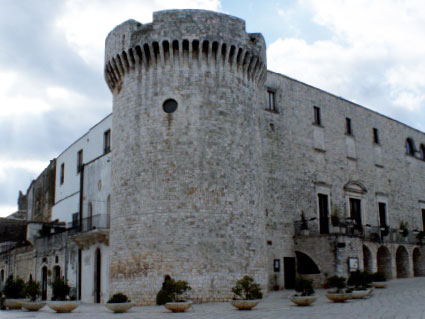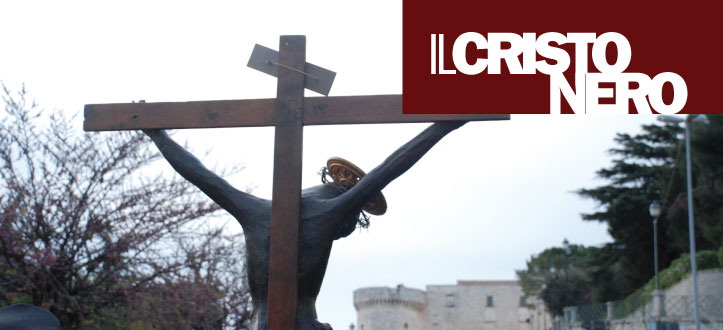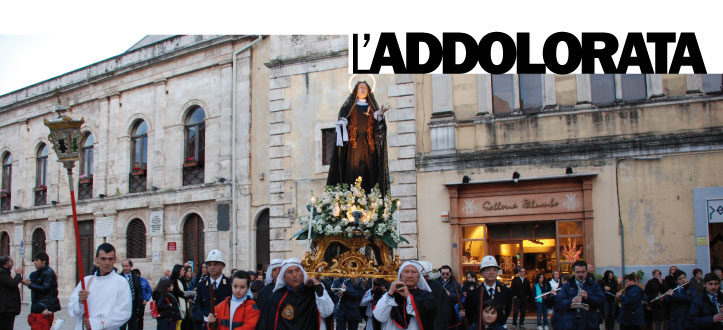





The most significant of the rites of the Holy Week in Conversano is surely that of the Kiss of the Black Christ. The Cross is kept in the church of Santa Maria dell’Isola, about one kilometre from the centre of the town, and during the evening of Holy Thursday the faithful make their way to the monastery dell’Isola to kiss and give thanks to Christ. The rite of the Kiss and the procession on the morning of Good Friday date back to long gone times when the monastery was inhabited by the „Zoccolanti“ Observant brothers of the Franciscan Order of San Bernadino of Siena. The history of Christ dell’Isola was first linked to the „Zoccolanti“ brothers, and then to the Tarsia-Mastronardi family; following the Unification of Italy in the 19th century, the ecclesiastical properties were dispossessed by the State and alienated from private individuals. The night after the Rector‘s Solemn vigil, at 3.00 a.m. in th morning of Good Friday, the procession of Christ moves off towards Conversano. A flute and drum with their plaintive notes open the procession, followed by the Cross and the faithful, mostly farmers, carrying large torches; the Christ dell‘Isola is surrounded by the floral wreaths, lamp bearers, and the Rector, and followed by a crowd of the faithful. During the first hours of dawn the „Ninna Nanna“ lullaby is sung to Jesus, a haunting song in the Conversano dialect. The procession proceeds very slowly because the Cross stops continually for the faithful to kiss it once again. Christ is then laid upon cushions covered in precious fabrics and adorned with garlands of flowers. At about 6.00 a.m. the Christ reaches the small church of San Rocco where the procession pauses for a little longer; from here onwards the Cross is carried only by the priests of Conversano and the bishop of the church of San Benedetto to the Palazzo dell’Episcopio. The procession moves on again at about 11.00 a.m. from the Palazzo Vescovile (bishop‘s palace) to the church of San Rocco, and on this stage the Tarsia Mastronardi family has the right to carry it, a right it will retain down to the last descendant. Another powerful moment of the procession takes place in Piazza Castello, with the Blessing of the sea, the earth, the seminary, and the town, by the Rector. From the church of San Rocco onwards, the procession follows the entire length of Via Bari, and reaches the church of Santa Maria dell’Isola at about 1.00 p.m.


Alongside these churches of notable value, there are others that the institutions pay less attention to, even though they too express the religious and historicalartistic traditions of the town. One of these is the Rectory della SS. Passione. Situated in the centre of the old town, on Corso Umberto I, it was built in 1665 by two priests from Conversano, don D’Ambrosia and don Quagliarella, with the intention of “stimulating the devotion of the people in memory of the Passion of Christ”. The church preserves and takes care of the eleven papier mâché statues of the “Mysteries”, carried in procession on the afternoon of Good Friday and the feast of Saint Lucy, celebrated on 13th December.
The oldest statues date back to the period between the end of the 18th and start of the 19th century: they are the Crucifixion (Calvary), and the Dead Christ (the Bier), which belong to the church della Passione, and the group of the Magdalenes owned by the Conversano municipal authority. The statues of Jesus in the garden, property of the Confraternity of St. Maria La Nova, no longer in existence, of the Flagellation of Christ (Christ at the column) owned by the Confraternity of St. Leonardo (this too no longer exists), of Christ crowned with thorns (Christ with the cane) belonging to the Confraternity of the SS. Sacramento, and Christ bearing the Cross, belonging to the Confraternity of the Immacolata, were made some years later. A number of statues donated by the bishop Monsignor Antonio Lamberti to the Confraternity of St Rocco (St. Peter), of the Annunziata (St John) and of the Passione (St Veronica), date back to the early 20th century.